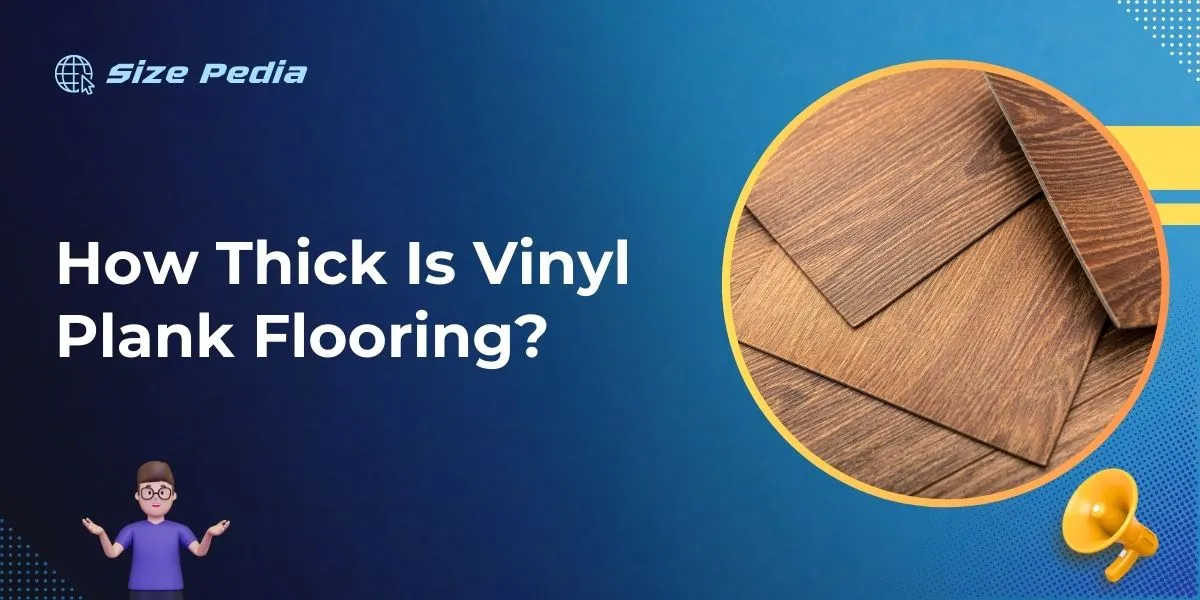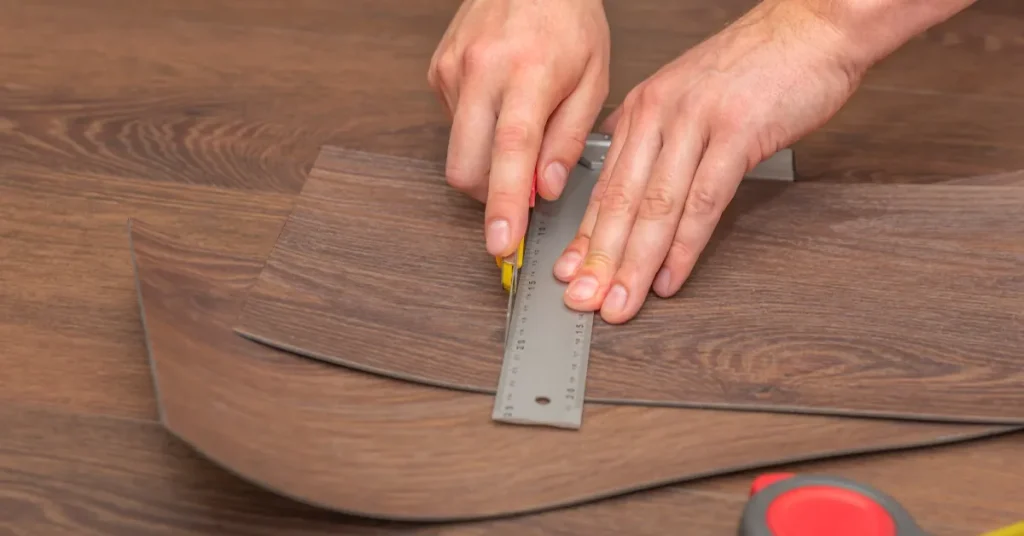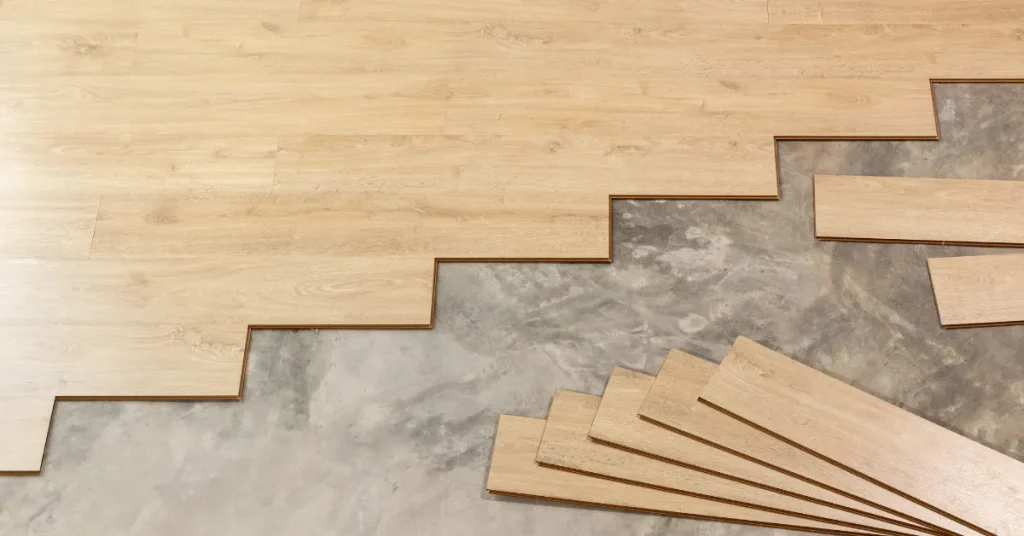Vinyl plank flooring typically ranges from 2mm to 8mm in thickness. The standard for residential use hovers around 4mm to 5mm.
Exploring the world of vinyl plank flooring presents a versatile and practical flooring option for homeowners and businesses alike.
This durable synthetic material not only mimics the aesthetic appeal of traditional hardwood floors but also offers enhanced resistance to moisture and wear.
As an increasingly popular choice, vinyl plank flooring stands out for its ease of installation and low maintenance requirements.
The varying thickness levels provide options to suit different needs, from light residential traffic to heavier commercial use.
Thinner planks are often more cost-effective, while thicker options provide better insulation, soundproofing, and a more realistic underfoot feel.
Selecting the right thickness of vinyl plank flooring can significantly impact the performance and longevity of your flooring investment.

The Basics Of Vinyl Plank Flooring
Vinyl plank flooring brings durability and style to homes. It’s a popular choice for areas with heavy foot traffic. The material mimics hard surfaces like wood. Yet, it maintains a comfortable feel underfoot.
Homeowners love its ease of installation. It often clicks together, floating over the subfloor. This flooring is both cost-effective and practical for busy lifestyles.
Composition Of Vinyl Plank
Vinyl plank flooring consists of several layers. The base layer provides stability. On top of it is the core, which determines durability.
The design layer offers a realistic look. Finally, the wear layer protects against damage. This structure ensures longevity and aesthetic appeal. Let’s break down these layers:
- Base layer: Forms the foundation, offering support.
- Core: Either flexible or rigid, affects the feel.
- Design layer: High-definition imagery, looks like real wood.
- Wear layer: Clear, tough, guards against scratches.
Market Varieties And Thickness Ranges
Vinyl plank flooring varies widely in thickness. Options range from 2mm to 8mm. Thicker planks feel more like real wood.
They reduce sound and offer better insulation. Thinner planks cost less and are easier to handle. They work well for temporary solutions or low-traffic areas.
| Thickness | Characteristics | Suitable Environment |
| 2-3mm | Light, flexible | Low traffic, quick fix |
| 4-5mm | Stable, residential use | Homes, offices |
| 6-8mm | Thick, commercial grade | High traffic, business areas |
Choose the right thickness for your space based on use and budget. Thicker planks generally provide a more luxurious feel. They are a wise investment for long-term use.
Measuring Thickness And Understanding Its Importance

When choosing vinyl plank flooring, thickness plays a key role. It affects durability, feel, and sound insulation.
Understanding and measuring the exact thickness of your vinyl flooring ensures you select the best option for your space.
Tools For Measuring Flooring Thickness
To accurately measure the thickness of vinyl plank flooring, you need the right tools. Simple yet effective tools give precise thickness readings. Let’s look at tools you might use:
- Vernier Calipers: These provide highly accurate measurements.
- Ruler: A standard ruler can suffice for a general guide.
- Tape Measure: Tape measures can also be used but are less accurate than calipers.
With calipers or a ruler, place the tool at the edge of a plank. Read the measurement. This tells you how thick the flooring is.
Why Thickness Matters For Vinyl Flooring
The thickness of vinyl flooring has several impacts on its performance:
| Thickness | Benefit |
| Thicker | More durable and stable |
| Moderate | Balanced performance |
| Thinner | Cost-effective but less durable |
Comfort underfoot and sound dampening also improve with thickness. A thicker vinyl reduces noise and feels softer to walk on. It’s necessary for busy homes and high traffic areas. Density is also crucial.
A dense, thick vinyl plank can withstand more pressure and last longer. When choosing vinyl plank flooring, consider the importance of both thickness and density. Together, they form the comfort and resilience of your flooring.
Standard Thicknesses And Their Applications
When choosing vinyl plank flooring, thickness matters. Each project has unique needs. Learn about standard thicknesses and their applications here.
Entry-level Residential Thickness
Vinyl plank flooring starts at entry-level thickness. This is for low traffic areas at home. Look at the common uses:
- 4 mm to 6 mm – Ideal for rooms with less foot activity.
- Light use such as in guest rooms or closets.
Remember, these planks suit spaces with fewer daily activities.
Commercial-grade Thickness For High Traffic
Commercial spaces need tough floors. See how thicker vinyl planks hold up in busy places:
- 6 mm – Works well for small businesses.
- Over 6 mm – Best for high-traffic areas like shopping centers.
Thicker planks reduce noise and resist wear. They provide a sturdy feel underfoot.
Here’s a quick guide to help you match thickness to the right space:
| Thickness | Application |
| 4-6 mm | Low traffic residential areas |
| 6 mm + | Commercial or heavy residential use |
Impact Of Thickness On Performance And Durability
When choosing vinyl plank flooring, thickness plays a key role. Thickness impacts both performance and durability. Thicker planks offer better sound insulation and can feel more stable underfoot. They tend to handle traffic better, offering a longer lifespan.
Wear Layer And Total Thickness Correlation
The wear layer is the topmost part of the plank. It resists scratches and stains. Total thickness includes the wear layer, core, and backing. A thicker wear layer means better protection for the flooring. This enhances overall durability and performance.
- 4 mil: Suitable for low-traffic areas
- 12 mil: Ideal for homes with regular traffic
- 20 mil or higher: Best for commercial spaces
Total thickness varies from 2mm to 8mm or more. Thicker floors often provide better insulation and comfort. These floors withstand heavy foot traffic better than thinner options.
Lifespan Expectations Based On Thickness
Lifespan is critically tied to thickness. A thick vinyl floor often lasts longer.
| Thickness (mm) | Expected Lifespan |
| <4mm | 5-10 years |
| 4mm-6mm | 10-15 years |
| >6mm | 15-20+ years |
Floors with at least 4mm thickness generally offer a good balance between cost and longevity. Floors thicker than 6mm are suited to high-traffic areas and can endure the rigors of daily life for longer periods.
Installation Considerations For Various Thicknesses
Choosing the right thickness for your vinyl plank flooring matters. The thickness affects durability, feel, and installation methods. It is important to consider how each thickness will interact with your space.
Now, let’s dive into the essential steps to ensure a flawless floor installation, no matter the thickness of your vinyl planks.
Preparing Subfloors For Different Thicknesses
A smooth and even subfloor is key for any vinyl plank flooring. Thicker vinyl can handle slight imperfections. Thinner planks need more subfloor preparation. Here’s how to prepare:
- Clean: Remove dust, dirt, and debris.
- Level: Fill dips and sand peaks in the subfloor.
- Inspect: Look for moisture issues and fix before installation.
Transitioning Between Different Flooring Types
When vinyl plank meets other flooring types, transitions matter. They keep floors looking neat and prevent tripping hazards. Here are key points for smooth transitions:
| Thickness | Transition Type | Installation Tips |
| Thick Planks | T-Molding | Allows room for expansion. Bridges the gap seamlessly. |
| Thin Planks | Reducer Strip | Levels out the height difference for a smooth step down. |
Always measure the height difference and choose the right type of transition strip. Match the color to your flooring for a consistent look.
Cost Implications Of Vinyl Plank Flooring Thickness

When choosing vinyl plank flooring, thickness matters. This feature affects not just the feel but also the cost.
Understanding the relationship between thickness and pricing is key to smart flooring decisions. Please read on to explore how the thickness of vinyl plank flooring can sway your budget.
Thickness Vs. Price Point Analysis
The thickness of vinyl plank flooring can significantly affect its price. Here’s a breakdown:
| Thickness | Average Price Range |
| 2mm – 3mm | $1 – $2 per sq. ft. |
| 4mm – 5mm | $2 – $4 per sq. ft. |
| > 6mm | $4+ per sq. ft. |
Thicker vinyl costs more but lasts longer. Thinner options save money yet may lack durability.
Balancing Budget And Quality Needs
It’s crucial to find a balance. Use this checklist to help:
- Determine usage: High-traffic areas need thicker vinyl.
- Check subfloor: Uneven surfaces require a thicker floor.
- Consider comfort: Thickness adds cushioning.
- Longevity: A thicker option may be a smarter long-term investment.
Choose the right thickness that fits your budget without compromising on quality. Sometimes, spending a bit more upfront can save you more in the long run.
FAQs About How Thick Is Vinyl Plank Flooring
What Is Best Thickness For Vinyl Plank Flooring?
The ideal thickness for vinyl plank flooring typically ranges from 4mm to 8mm. Thicker planks, around 6mm to 8mm, provide enhanced durability and a more realistic hardwood feel.
How Thick Is 20 Mil Vinyl Flooring?
20 mil vinyl flooring is approximately 0. 02 inches or 0. 5 millimeters thick. This durable thickness offers good wear and tear resistance for high-traffic areas.
Is 12 Mil Vinyl Plank Flooring Good?
Yes, 12 mil vinyl plank flooring is durable, resists scratches and wear, and suits moderate foot traffic areas effectively.
Is Vinyl Plank Thicker Than Laminate?
Vinyl plank flooring can vary in thickness, typically ranging from 2mm to 8mm. Laminate flooring generally falls between 6mm and 12mm. Thus, laminate is often thicker than vinyl plank.
Conclusion
Understanding vinyl plank flooring thickness is essential for any flooring project. Choose the right thickness to ensure durability, comfort, and noise reduction. Opt for commercial-grade for high traffic areas.
For residential spaces, a mid-range option suffices. Select wisely to enhance your space for years to come.
Resources:
1. https://www.epa.gov/formaldehyde/questions-and-answers-regarding-laminate-flooring
